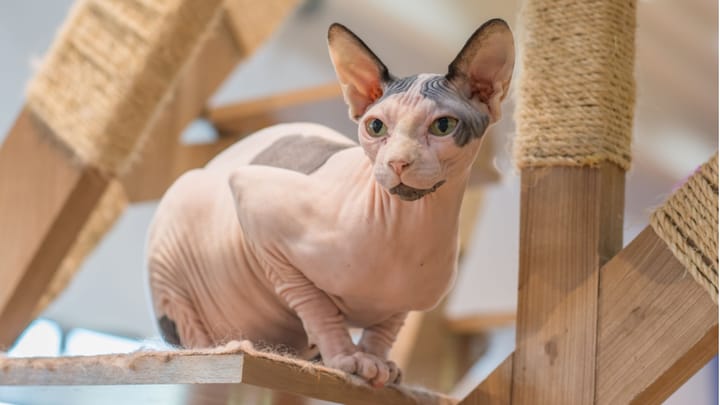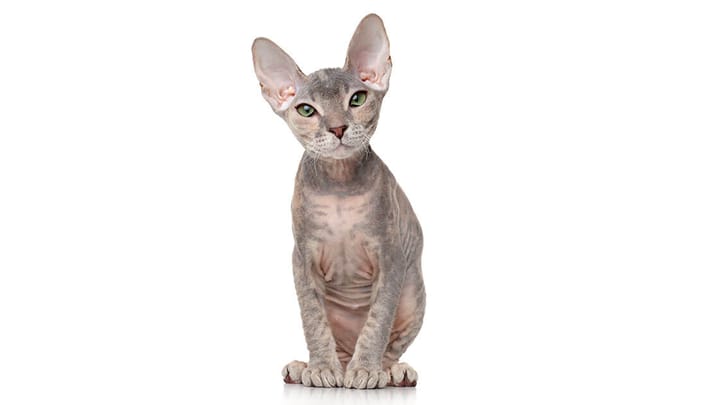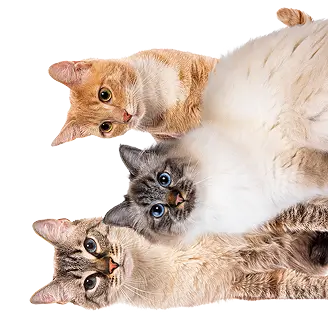Donskoy
Other names : Don Sphynx, Don Hairless


People’s reaction when first meeting a Donskoy is often something like: “What the heck is that?!” Indeed, their appearance is most unusual. But if you get to know these cats, you can only fall in love with them - as much for their physique as for their personality, Donskoys are endearing cats that deserve to be known and loved. Their almond eyes and the special texture of their skin and all its folds will either charm you or repulse you - but if we can be sure of one thing, it’s that no one can be indifferent when faced with so much uniqueness.
|
Life expectancy |
The Donskoy has a life expectancy of between 12 and 15 years |
|
Temperament |
|
|
Adult size |
Female
Between 10 and 12 in
Male
Between 10 and 12 in
|
|
Adult weight |
Female
Between 4 and 7 lb
Male
Between 9 and 11 lb
|
|
Coat colour
GCCF recognises all colours in the traditional and pointed categories, in any divisions except with the colour amber. TICA recognises all colours and all categories, in all divisions. |
Black Brown White Red Cream Blue |
|
Type of coat
nude, but sometimes with light down on the nose, ears, tips of the paws, tip of the tail and genital area The Donskoy carries a dominant gene that causes the loss of any hair that they may have when they are born. There are 4 types of nudity:
One of the special features of the Don Sphynx is that in the winter season, they can grow a coat! It consists of a fine wool on the chest, along with hairs at the end of the tail. They then lose it later on when the temperature gets milder again. |
Naked |
|
Eye colour
There is contradiction between sources on this point. TICA and GCCF, both agreed on the fact that all colours are allowed: blue / aquamarine, golden yellow, green, odd / dichroic |
Blue
Green
Yellow
Odd-eyed
|
Just like humans, these naked cats sweat through their skin.
Do you know the difference between a Sphynx and a Donskoy? The Sphynx is from Canada, while the Donskoy is from Russia. Both breeds carry a gene that is responsible for their nudity, but in the Sphynx this gene is recessive (meaning it is not always expressed), whereas in the Donskoy it is dominant. This also affects the shape of their face, eyes and muzzle. It is believed that the more pronounced the nudity of the kitten when they are born, the more pronounced their facial features will be.
More details about the Donskoy
Donskoy: Origins and history
These cats are from Russia and their history dates back to 1987, the year that the original cat was discovered in the city of Rostov-on-Don. Elena Kovaleva found a kitten in a pitiful state and took her in, naming her Varvara. As Varvara grew up, she began to lose her hair gradually and Elena tried giving her treatments to stop it but nothing worked. A few years later, Varvara gave birth to a litter of kittens, some of which were completely naked and others had hair. Then, the kitten with hair began to lose it just like his mother. Elena contacted Irina Nemikina, a renowned Russian breeder, who adopted one of the kittens and made various crosses. As fully naked kittens appeared in each litter, Irina quickly understood that this was a dominant genetic mutation (unlike for the Sphynx) and the Donskoy was born.
Physical characteristics of the Donskoy
While their nakedness might make them seem fragile and delicate, Donskoys are far from frail. They are sturdy, strong and agile.
Donskoy: Characteristics
Donskoy: Behaviour
Breed compatibility Donskoy
Donskoy: Purchase price
We do not have enough data to set an average price for a Donskoy, however it will vary according to the lineage, breeding, age and even the sex. For your monthly budget you should allow on average £35 per month to cater to your cat’s needs, by offering them a quality diet and ensuring they stay healthy.
Donskoy: Shedding
None
It pretty much goes without saying that these cats don’t lose any fur. You can rest assured that your sofas and your floors will always be flawless. Or at least, there won’t be any fur, but you may find little traces of sebum on pale surfaces.
Donskoy: Grooming
Because they lack fur to absorb excess oil, Donskoys’ skin can be oily to the touch. It is recommended that you bathe them no more than once every 6 months, as the more you wash them, the more sebum they will produce. To clean the accumulated sebum between baths, you could use a damp flannel or something similar. Their ears will also require special attention - it is advisable to clean them every week. And don’t forget to clean between their toes and on the underside of their paws between the pads.
Donskoy: Health
They can live for between 12 and 15 years.
As you’d imagine, these cats are not built for the cold. That said, they are very good at withstanding heat, and they particularly enjoy basking in the sun. However, it’s important that you’re careful to ensure they don’t get painful sunburn.
It is advised that you calculate their food portions carefully with the help of your vet in order to ensure that your cat doesn’t end up overweight - they are susceptible to being on the greedy side after all.
- This breed is not predisposed to any diseases in particular, although some sources mention a significant incidence of pulmonary diseases.
- Donskoys may also develop the same conditions as any other cat eventually, such as oral diseases.
On this point there are contradictions: TICA authorises pairings with the Domestic Shorthair, whereas LOOF only recognises pairings between Donskoys.





